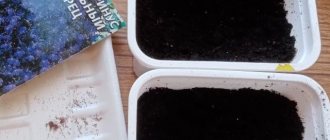Recently, beautiful exotic plants have often appeared in our homes and gardens. One of these is the Madagascar native Catharanthus rosea, sometimes called Pink periwinkle. Its tiny, five-petaled flowers, which appear from June to October, resemble periwinkle inflorescences. The species is usually grown in pots, less often used as an annual ground cover plant that forms spectacular carpets. In this article we will tell you how to plant catharanthus; growing and caring for the flower is not difficult; you just need to decorate your garden with it.
What varieties of catharanthus are grown from seeds?
Among the most popular varieties of catharanthus in cultivation are the following:
- Titan . It is distinguished by the rich pink color of its petals. Suitable for growing in hanging pots.
- Sicily features bright pink flowers. Grows best in sunny areas.
- Blackberry Jam . It differs from other varieties in being more resistant to drought. The flowers are large, velvety, deep purple.
- Pacifica Regiment . A distinctive feature of the variety is its rather large snow-white flowers. He prefers sunny areas.
- Courage has more pointed leaves. Petals are pink and white. Makes more demands on the soil. Loves well-ventilated and sunlit areas.
What catharanthus looks like, photo
Catharanthus is a flowering plant native to Madagascar. It has the appearance of a subshrub up to 50–60 cm high.
The inflorescences are pink, darker in the middle of the flower. There are also white, blue and purple shades.
The leaves are oval, oblong, rich in color with a slightly lighter central vein.
When to plant catharanthus seedlings, in what month
Catharanthus is characterized by slow development, so you should not delay planting seeds. Flowering begins 5-6 months after the first shoots appear. Therefore, if you want catharanthus to bloom in mid-summer, you need to sow it in January-February.
ON A NOTE. However, if desired, it is permissible to plant later. For example, sowing seeds in March will allow for later flowering closer to autumn. But in April there is no point in planting seeds.
Reviews from gardeners
Tanya, Samara
I have had catharanthus growing for several years. I sowed it with seeds and at first grew it as an indoor flower. There were a lot of shoots and there were no problems with it, except that it loves water very much, and in the summer I planted it in the garden.
Source: www.forumhouse.ru
Julia, Ramenskoye
Sowing is done in the spring, in February-March, in light sandy soil, having previously treated the seeds with a solution of potassium permanganate. Shoots appear in 7-10 days. Seedlings develop very quickly.
Source: forum-flower.ru
Planting a flower for seedlings depending on the region
In general, it is recommended to plant seeds of flower and vegetable crops, focusing on the climatic characteristics of the growing region.
But, since catharanthus has a long growing season, it is best to plant it in any region in January and February. In the northern cold regions (Urals, Leningrad region, Siberia), it is advisable to sow in the second half of February. But in the middle zone, and even more so in the South, you can safely sow on the favorable days of the first winter month.
Favorable days for planting catharanthus in 2022 according to the lunar calendar
The most suitable days for sowing seeds are the days of the waxing lunar phase. During this period, germination processes are activated, seeds germinate better, and seedlings are less sick later.
The table below shows the most favorable timing for planting catharanthus seeds for seedlings.
| Month | Good days for planting |
| January | 3 — 17 |
| February | 2 — 15 |
| March | 3 — 17 |
ON A NOTE. Periods of the waning moon are also suitable for planting, but you must take into account that seeds germinate less easily and seedlings are more susceptible to stretching.
Seedling care
Out of 100 catharanthus seeds, 85-90 sprouted. Well, this is a very good germination percentage. However, sowing and germinating seeds is not the most difficult stage in growing flowers.
It is much more difficult to grow healthy and strong seedlings. To do this, you need to create the necessary conditions, otherwise the seedlings may stretch out, greatly lose quality and even die.
When is it not worth planting catharanthus seedlings in 2022 according to the lunar calendar?
In addition to favorable days for planting seeds for subsequent cultivation, there are times when sowing is prohibited. According to the lunar calendar, these are new moon and full moon.
The table below provides detailed information on unfavorable planting times in the first three months of 2022.
| Month | Bad days for planting |
| January | 2, 18 |
| February | 1, 16 |
| March | 2, 18 |
What is needed for planting catharanthus seedlings
Having decided on the timing of planting, they begin to prepare the necessary materials for the procedure.
How to choose the right catharanthus variety?
Typically, when choosing a variety of flower or vegetable crop to plant, the type of variety is taken into account. Late varieties are not suitable for growing in the harsh northern Russian regions.
But in the case of catharanthus, this is not necessary. All flower varieties develop very slowly. Therefore, you can focus on choosing the variety that you like best in appearance.
How to choose seeds for planting
It is best to buy catharanthus seeds for growing at a flower or hardware store. You should choose trusted manufacturers. This will be a kind of guarantee of good germination of the grains.
Do not take too old planting material. Ideally, he should be 2, maximum 3 years old.
Please note that if you purchase granulated, coated and other similar seeds, you do not need to further process or soak them.
What soil is needed for planting catharanthus?
Like almost all garden flowers, catharanthus when growing seedlings must be sown in a light, loose and, most importantly, nutritious substrate. The ideal solution is the most common soil for seedlings. Floral would also work. For example, the one used for geraniums or violets.
But it’s better not to use garden soil. Firstly, in winter or March it will need to be defrosted. Secondly, mix in peat and sand. Thirdly, treat with a fungicide or bake in the oven. It is much easier to use ready-made soil.
How to prepare seeds for sowing seedlings
Before planting, it is recommended to properly prepare the seeds for sowing. Preparation includes treatment against diseases and stimulation of growth.
You can use both commercial products for soaking (Epin, Zircon, Fitosporin - soak according to instructions) and folk remedies (hydrogen peroxide - a teaspoon per glass of water, potassium permanganate - 1 gram per glass of water).
After soaking, the grains must be washed in running water and dried.
What not to do when planting catharanthus
When planting catharanthus, you should not bury the grains too deep, otherwise many of them will not be able to hatch. The optimal depth is no more than 0.5 - 1 cm.
You should not leave the soil unmoistened, but in no case allow it to become waterlogged, otherwise the seeds may begin to rot. It is optimal to moisten the soil with a spray bottle after planting.
Planting catharanthus seedlings at home, step-by-step photos
There are several ways to sow catharanthus. The three most popular are: sowing in a common container, planting in separate containers and growing in peat tablets.
Let's look at all three methods in more detail.
Sowing in a common container
The easiest way to plant catharanthus is to sow in a common container. The algorithm is like this:
Drainage holes are made in the seedling container. You can also fill drainage to the bottom.
Pour soil into the box.
Make parallel grooves at a distance of 2 cm from each other.
Sow seeds. It is advisable to maintain a planting step of 2 cm, but if nothing bad happens, you will just need to thin out the seedlings.
Gently moisten the soil with a spray bottle.
The crops are covered with soil.
Wrap in cling film, cover with glass, a plastic lid or tie in a bag and place in a warm place for germination.
Planting in separate containers
The only difference with the previous method is that you need to sow not in a common container, but in separate containers. Most often these are plastic cups.
Take the required number of plastic cups. Make drainage holes in them and fill them with soil.
Make a small hole in the center (about 1 cm deep).
Plant 2-3 seeds using tweezers or a toothpick.
Moisten with a spray bottle.
Covered with earth.
Next, all the cups are placed in one tray, a bag is put on top and placed in a warm place for germination.
Growing in peat tablets
Peat tablets are good because when growing in them there is no need to additionally feed the flowers. In addition, there is no need to pick up seedlings, and when transplanting to a flowerbed, you just need to bury the seedling in the ground.
The tablets are placed in one container and filled with water.
When they swell, the grains are sowed.
Next, lightly sprinkle with a top layer of peat.
Cover with a plastic lid and leave in a warm place for germination.
How to care for catharanthus seedlings
After planting, the crops need to be properly cared for to achieve good germination.
Caring for catharanthus immediately after sowing until germination
By tying the crops in a bag or covering them with a transparent lid, you have created a greenhouse effect, which is most favorable for the appearance of sprouts.
The only problem is that condensation accumulates inside and there is no fresh air. Therefore, you need to regularly ventilate the crops, removing coverings, and also moisten the soil as necessary, preventing it from drying out.
Care after emergence
When the first shoots appear, the shelter is removed. Now the containers with seedlings are moved to a warm, well-lit and draft-protected place, where the seedlings will remain until planted in open ground.
How to care for catharanthus seedlings
Now you need to take care of the catharanthus. The basic rules are below.
Watering
The main event during growing seedlings. The frequency of watering also depends on the microclimate of your home. When it is necessary to water, they are guided by the soil itself. You can't let it dry out. As soon as the top layer dries, you can water it.
IMPORTANT! Remember that overwatering is fraught with the development of fungal diseases.
Location and lighting
Catharanthus seedlings should be placed in a well-lit place away from drafts. If you place the seedlings on a windowsill, make sure that the leaves do not touch the glass.
If you planted in January or early February, you may need additional lighting from phytolamps. The fact is that for normal development, seedlings need at least 12 hours of daylight.
Top dressing
According to the schedule, it is necessary to feed the catharanthus for the first time no earlier than 2 weeks after picking. In this case, complex liquid fertilizers are used. For example, Agricola for flowering plants.
If the seedlings get sick, drop their leaves and stretch out, then fertilizing can be done earlier. In addition to fertilizers, it is recommended to use growth regulators Epin or Zircon, which strengthen plant immunity.
Growing and care
Catharanthus, native to the islands of Madagascar, will bring a little tropical beauty to our garden. It has a high decorative value, tolerates heat and drought well, and is undemanding in care. You need to know how to properly care for plants so that they bloom continuously all summer, until autumn.
Position in the garden
Catharanthus requires strong lighting and does not bloom in shaded areas. It develops better on window sills and in the garden - in well-lit places. It also tolerates partial shade, but must be in direct sunlight 8 hours a day. It is recommended to place it in a place protected from rain, because drops of water falling on the flowers leave unsightly spots on the petals.
Catharanthus thrives at a soil temperature of about 18 °C. If the summer is wet and cool, we will get poor results that do not reflect the capabilities of the plant.
Watering
Catharanthus must be watered with such frequency that it does not dry out and does not suffer from excess moisture. It is better to use moderate watering to keep the soil slightly moist at all times. In hot weather, plants in boxes and pots need to be watered frequently.
When there is a lack of moisture, they droop their leaves, but when moistened they quickly raise them.
Feeding
Care at home and in open ground includes catharanthus fertilizer. Throughout the growing season, you need to feed the flower using potassium-rich multicomponent fertilizers for flowering plants (usually they contain a high dose of potassium), which have a beneficial effect on flowering.
Feed in spring and summer once every 2-3 weeks, the last time in August.
A fragment of the main shoot
In order for the plant to bloom beautifully, simultaneously blooming many flowers, it is worth removing the upper peduncle on the main shoot while it still forms a small bud. When the central shoot is broken, side stems will develop faster.
Diseases, pests
The great advantage of pink catharanthus is its resistance to pests and diseases. One of the most common problems that can be encountered when growing catharanthus is root rot, caused by too much watering. The plant is also prone to leaf chlorosis.
Wintering
Catharanthus does not tolerate cold and frost. Damage may occur when temperatures drop below 4°C. When the season is over, there is no need to throw the plant into the compost; with a tunnel or greenhouse at your disposal, the catharanthus can overwinter in safe, stable conditions.
The flower can be stored in winter in a cool room (15-18 ° C). During this period, it is watered very little and no fertilizing is done.
Flower pick
If you planted in a common box, you will need a pick. They dive at the stage of development of 2-3 true leaves.
ON A NOTE. The first pair is always the cotyledon leaves.
Containers are selected for picking. Again, plastic cups will do. They are filled 2/3 with soil.
Next, using a spoon, carefully remove the seedling from the container and transfer it to a new place.
Add soil and water lightly.
Diseases and pests
| Aphid Ways to fight:
| |
| Brown rust Ways to fight:
| |
| Chervets Ways to fight:
|
Planting catharanthus in open ground
Like many other flowering plants, catharanthus can be planted from seeds directly into open ground. Growing in this way is associated with a number of difficulties and is more suitable for the southern regions of our country.
Which varieties are suitable for planting in open ground?
Catharanthus can be planted both in a flower bed and in hanging flower pots.
For direct planting in open ground, you can consider the following varieties: Peppermint kule, Blockbuster F1, Kora F1, Valiant F1.
When can catharanthus be planted in open ground?
Sowing seeds is recommended in late April or early May, depending on when the growing region experiences warm temperatures.
How to plant in open ground, step by step?
Sowing seeds in open ground is similar to planting them in a common container, with minor differences.
First, the soil for planting must be prepared. To do this, they dig it up, loosen it and remove all weeds and other debris.
Next, make parallel shallow grooves 1-2 cm deep. Maintain at least 30 cm between the grooves.
The grooves are moistened, and then seeds are planted in them and covered with soil.
If the weather has not yet settled, you can cover the crops with agrofibre.
Reproduction and planting
Propagating catharanthus from seeds is not difficult; they are large in size compared to some seeds of balcony plants, such as petunia, and therefore have a better chance of germination. Seeds can be purchased at garden centers, ordered online, or collected from the mother plant.
It is worth learning how to grow catharanthus and propagation methods, since due to the lack of frost resistance it is grown in our gardens as an annual plant. Of course, you can try to provide wintering for this heat-loving plant, providing it with a temperature of about 15-17 degrees C, but after 2-3 years the bush significantly loses its beauty. The best way to permanently place catharanthus in the garden, balcony or terrace is to propagate annually. Fortunately, the plant is easily propagated by cuttings or sowing seeds.
Collecting seeds
When the growing season ends, the catharanthus flowers will begin to set seeds. They are located in cylindrical sacs located under the leaves. It is important to have time to collect the seeds before the bag doors open. When the fruit turns from green to yellowish-brown, it is time to collect the seeds. Place the fruits in a paper bag and place them in a warm, dry place so they can dry thoroughly.
Drying seeds
To speed up the process of obtaining seeds, you can shake the bag every day. When the leaflets are dry, carefully open them, picking out the seeds from inside. Some gardeners obtain seeds by placing the fruit in a shallow, open container exposed to direct sunlight.
Place the seeds in a paper envelope and place them in a cool, dry place to keep them safe until next spring. Storing seeds at low temperatures will facilitate rapid germination.
Planting seeds
The best time to plant catharanthus seedlings is the end of winter or early spring, then the plant blooms from late spring to autumn. The best place for germinating seeds and growing seedlings is a film tunnel or greenhouse, where you can control the climate, creating the most favorable conditions for plants at each stage of their development.
Sowing:
- Fill the containers with universal soil, mixed with garden soil with the addition of peat and sand.
- Now you can sow catharanthus seeds in containers filled with prepared substrate. Sow so that they are 1-2 cm below the soil surface.
- Catharanthus seeds require full shade to germinate. You can cover the pots with opaque film or newspapers. It is also important to provide them with the correct temperature - catharanthus requires about 25 degrees C to germinate.
- After 10 days, the seedlings should rise, then care should be taken to lower the temperature (optimally 20 degrees C) and expose the sprouts to sunlight.
- When the seedlings reach a size of about 7 cm and produce 4 true leaves, you can think about transplanting the plants outside. It is safest to transplant catharanthus into open ground or pots on the balcony after May 15, when the risk of frost has passed, since the flower is extremely sensitive to frost.
- If you decide to plant catharanthus seedlings in open ground, you need to maintain the appropriate distances (30-60 cm).
- Be sure to trim the tops of the shoots of young shoots, so the plant will take on a more branched, compact appearance.
Propagation by cuttings
Catharanthus is easily propagated by the vegetative method, shoot cuttings. This method of propagation has the advantage that, unlike generative propagation (from seeds), it guarantees that the cuttings will exactly repeat the appearance of the mother plant.
Reproduction by cuttings - step by step:
- Obtaining cuttings. The best time to collect catharanthus cuttings is spring, although some do it in early autumn, keeping them in a bright, cool room during the winter. The parent plant must be healthy and strong. For cuttings, young, fragile shoots are selected and cut to 7-10 cm in length.
- Planting catharanthus seedlings. Be sure to remove the bottom of the leaves and leave a few of the top leaves. To speed up the process of creating a root system, soak the bottom of the cut in Kornevin. Place the cuttings in a mixture of compost soil, sand and peat.
- Rooting cuttings. To create the warm, moist environment most favorable for cuttings to grow, cover them with a lid or plastic wrap. The optimal temperature required for proper rooting of catharanthus cuttings is 22-24 degrees C. The cuttings need to be provided with a temperature of at least 7 ° C. At the initial stage, the cuttings should be placed in a shady place. Later, before transplanting the seedlings into larger pots, they are gradually accustomed to more intense lighting.
Some gardeners prefer to root catharanthus in winter. They place the cuttings in water, and at the end of winter, when the plants have produced sufficient root length, they transplant them into gardening mixture.
Planting and care in open ground, pots
When the risk of frost passes and night temperatures no longer fall below 12 degrees C, you can transplant the cuttings outside, remembering to harden them first. The seedlings begin to grow quickly with the onset of warm nights.
Catharanthus comes from an exotic climate, so a warm, sunny, draft-free area with fertile, well-drained humus soil is chosen for it. A place where the plant will be protected from rain would be preferable; heavy rainfall can destroy the flower petals.
Catharanthus prefers sandy loam soils. Well-drained, rather poor soils are best suited for this plant. On fertile soils we will get powerful plants with strong leaf mass, but little flowering. In open ground, soils need to be moderately fertile, clay-sandy, not heavy.
When planting catharanthus in pots, the substrate chosen is typical for potted plants: slightly acidic peat-humus soil with the addition of sand and a mandatory layer of drainage at the bottom of the pot.
Planting catharanthus seedlings in open ground
At the end of May - beginning of June, catharanthus seedlings can be transplanted to a permanent place in the garden or in a flower bed.
How to choose a place to plant catharanthus?
This flower culture prefers well-lit areas, protected from wind and drafts. The soil should be loose and nutritious.
What can you plant catharanthus next to?
Catharanthus looks good both as part of flower arrangements and when grown alone.
It can be planted together with snapdragons, aster, phlox and other crops. The main thing is to choose the right color combinations.
How to prepare catharanthus seedlings for planting in open ground?
Before planting, seedlings must be hardened, that is, prepared for further growth in more severe conditions. To do this, they begin to take them out onto the street or open balcony a week or two before planting. First, the seedlings are left outdoors for half an hour, then the time is gradually increased.
How to prepare a place for planting catharanthus outdoors
The area under the catharanthus needs to be dug up, all weeds removed and the soil thoroughly loosened. It wouldn’t hurt to add organic or mineral fertilizers ahead of time. But it is recommended to do this at least a month before planting.
What kind of plant is this, how does it differ from other species?
Catharanthus ampelous is an unpretentious and undemanding plant . Evergreen, perennial bush. It can be found in China, Indonesia and the Philippine Islands.
Catharanthus feels good both in open ground and when grown on a windowsill. The flowers bloom gradually, filling the entire stem and ultimately forming a dense bush.
At home, it requires constant pruning , without which it gradually loses its attractive appearance. Strongly overgrown shoots become bare and lose their flexibility. However, it is worth noting that even during the rest period it looks very elegant.
For a long time, they did not distinguish between catharanthus and periwinkle, mistaking them for the same plant of the Kutrov family. And only in the middle of the 20th century, scientists identified catharanthus as a separate genus of evergreen perennial plants.
The main difference between the ampel type and others is the long stems , lowered down, along the entire length of which flowers bloom, also lowered down. Other traditional representatives of this species have erect shoots, and flowers envelop them, creating lush caps.
Caring for catharanthus after planting in open ground
Caring for a flower is not at all difficult. For example, you will only have to weed the first time, since then the catharanthus will grow.
It is necessary to water with heated water. It is important to keep the soil slightly moist; if this is not done, the plant's leaves will begin to curl.
Already a week after transplantation, fertilizing begins. Use complex liquid fertilizers or a solution of ash. Feed once every 2 weeks, alternating root and foliar feeding. For spraying, you can use the drug Epin-Extra.
Low maintenance
Externally, catharanthus resembles periwinkle.
Photo: stroy-podskazka.ru Description:
- Catharanthus ampelous - (lat. Catharanthus) a genus of perennial herbaceous plants, as well as subshrubs.
- Prefers fertile, well-moistened soil . It spreads quickly and occupies all available space on the site.
- Propagated by seeds and vegetatively . Sometimes gardeners use cuttings.
The plant has a taproot system.
Photo: mir-ogorodik.ru The author of the story shares the secrets of growing ampelous catharanthus at home. Recommends feeding the plant with “Florist Bud” fertilizer:











